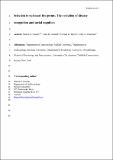Files in this item
Selection to outsmart the germs : the evolution of disease recognition and social cognition
Item metadata
| dc.contributor.author | Kessler, Sharon E. | |
| dc.contributor.author | Bonnell, Tyler R. | |
| dc.contributor.author | Byrne, Richard W. | |
| dc.contributor.author | Chapman, Colin A. | |
| dc.date.accessioned | 2018-05-17T23:33:05Z | |
| dc.date.available | 2018-05-17T23:33:05Z | |
| dc.date.issued | 2017-07 | |
| dc.identifier | 249252441 | |
| dc.identifier | 604d5a16-baed-4810-a634-22151e68ee26 | |
| dc.identifier | 85019493632 | |
| dc.identifier | 000404708200007 | |
| dc.identifier.citation | Kessler , S E , Bonnell , T R , Byrne , R W & Chapman , C A 2017 , ' Selection to outsmart the germs : the evolution of disease recognition and social cognition ' , Journal of Human Evolution , vol. 108 , pp. 92-109 . https://doi.org/10.1016/j.jhevol.2017.02.009 | en |
| dc.identifier.issn | 0047-2484 | |
| dc.identifier.other | ORCID: /0000-0001-9862-9373/work/60630575 | |
| dc.identifier.uri | https://hdl.handle.net/10023/13387 | |
| dc.description | This work was funded by the Fonds de Recherche du Québec – Nature et Technologies and the Québec Center for Biodiversity Science. | en |
| dc.description.abstract | The emergence of providing care to diseased conspecifics must have been a turning point during the evolution of hominin sociality. On a population level, such care may have minimized the costs of socially transmitted diseases at a time of increasing social complexity, although individual care-givers would have potentially incurred increased transmission risks while providing care. We propose that care-giving likely originated within kin networks where the costs of providing care may have been balanced by fitness increases obtained through caring for ill kin. We test a novel theory of hominin cognitive evolution in which disease may have selected for the cognitive ability to recognize when a conspecific is infected. Moreover, because diseases may produce symptoms that are likely detectable via the perceptual-cognitive pathways integral to social cognition, we suggest that disease recognition and social cognition may have evolved together. We use agent-based modeling to test 1) under what conditions disease can select for increasing disease recognition and care-giving among kin, 2) whether the strength of selection varies according to the disease’s characteristics, 3) whether providing care produces greater selection for cognition than an avoidance strategy, and 4) whether care-giving alters the progression of the disease through the population. We compare the selection created by diseases with different fatality rates (i.e., similar to Ebola, Crimean-Congo hemorrhagic fever, measles, and scabies) under conditions where agents provide care to kin and under conditions where they avoid infected kin. The greatest selection was produced by the measles-like disease which had lower risks to the care-giver and a prevalence that was low enough that it did not disrupt the population’s kin networks. When care-giving and avoidance strategies were compared, we found that care-giving reduced the severity of the disease outbreaks and subsequent population crashes. The greatest selection for increased cognitive abilities occurred early in the model runs when the outbreaks and population crashes were most severe. Therefore, we conclude that over the course of human evolution, repeated introductions of novel diseases into naïve populations could have produced sustained selection for increased disease recognition and care-giving behavior, leading to the evolution of increased cognition, social complexity, and, eventually, medical care in humans. Finally, we lay out predictions derived from our disease recognition hypothesis of hominin cognitive evolution that we encourage paleoanthropologists, bioarchaeologists, primatologists, and paleogeneticists to test. | |
| dc.format.extent | 18 | |
| dc.format.extent | 1826905 | |
| dc.language.iso | eng | |
| dc.relation.ispartof | Journal of Human Evolution | en |
| dc.subject | Agent-based model | en |
| dc.subject | Disease transmission | en |
| dc.subject | Cooperation | en |
| dc.subject | Hominin evolution | en |
| dc.subject | Social complexity | en |
| dc.subject | Kin selection | en |
| dc.subject | RC0321 Neuroscience. Biological psychiatry. Neuropsychiatry | en |
| dc.subject | BF Psychology | en |
| dc.subject | DAS | en |
| dc.subject | SDG 3 - Good Health and Well-being | en |
| dc.subject.lcc | RC0321 | en |
| dc.subject.lcc | BF | en |
| dc.title | Selection to outsmart the germs : the evolution of disease recognition and social cognition | en |
| dc.type | Journal article | en |
| dc.contributor.institution | University of St Andrews. School of Psychology and Neuroscience | en |
| dc.contributor.institution | University of St Andrews. Centre for Social Learning & Cognitive Evolution | en |
| dc.identifier.doi | 10.1016/j.jhevol.2017.02.009 | |
| dc.description.status | Peer reviewed | en |
| dc.date.embargoedUntil | 2018-05-17 | |
| dc.identifier.url | http://www.sciencedirect.com/science/article/pii/S0047248417301094#appd001 | en |
This item appears in the following Collection(s)
Items in the St Andrews Research Repository are protected by copyright, with all rights reserved, unless otherwise indicated.

